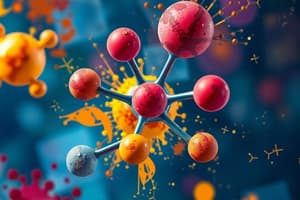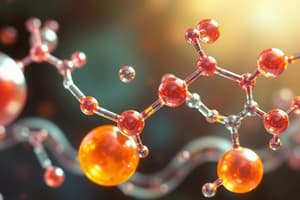Podcast
Questions and Answers
What is the primary focus of biochemistry?
What is the primary focus of biochemistry?
- Study of heredity and variation
- Chemical processes of living organisms (correct)
- Effects of drugs on living organisms
- Preparation and dispensing of medical drugs
Which discipline is primarily concerned with the functions and activities of life?
Which discipline is primarily concerned with the functions and activities of life?
- Pathology
- Physiology (correct)
- Genetics
- Pharmacology
Which discipline studies the effects of poisonous chemicals on living organisms?
Which discipline studies the effects of poisonous chemicals on living organisms?
- Pathology
- Pharmacology
- Toxicology (correct)
- Pharmacy
How can knowledge of biochemistry be applied?
How can knowledge of biochemistry be applied?
What is the study of the structural and functional deviations that constitute disease called?
What is the study of the structural and functional deviations that constitute disease called?
What is the primary role of enzymes in cellular processes?
What is the primary role of enzymes in cellular processes?
Which of the following is NOT one of the basic needs of cells?
Which of the following is NOT one of the basic needs of cells?
What identifies that a cell possesses genetic information?
What identifies that a cell possesses genetic information?
What is considered the energy currency of the cell?
What is considered the energy currency of the cell?
Which of the following properties is characteristic of a cell?
Which of the following properties is characteristic of a cell?
What is the basic structural and functional unit of life?
What is the basic structural and functional unit of life?
Which of the following is NOT a class of bio-organic molecules?
Which of the following is NOT a class of bio-organic molecules?
Which functional group is characteristic of both alcohols and phenols?
Which functional group is characteristic of both alcohols and phenols?
What is one characteristic of biochemical reactions in biological systems?
What is one characteristic of biochemical reactions in biological systems?
Which of the following is considered a biochemical process involving the addition of molecules?
Which of the following is considered a biochemical process involving the addition of molecules?
Which macromolecule primarily composes the plant cell wall?
Which macromolecule primarily composes the plant cell wall?
What reaction type involves breaking down compounds by the addition of water?
What reaction type involves breaking down compounds by the addition of water?
Which of the following molecules contains a 5-C sugar, nitrogen ring, and phosphate group?
Which of the following molecules contains a 5-C sugar, nitrogen ring, and phosphate group?
What is one of the primary functions of the Golgi Apparatus?
What is one of the primary functions of the Golgi Apparatus?
Which organelle is known as the 'suicide bag' of the cell?
Which organelle is known as the 'suicide bag' of the cell?
What process occurs within the chloroplast?
What process occurs within the chloroplast?
What does the Endoplasmic Reticulum primarily contribute to?
What does the Endoplasmic Reticulum primarily contribute to?
What is one key difference between prokaryotic and eukaryotic cells regarding the nucleus?
What is one key difference between prokaryotic and eukaryotic cells regarding the nucleus?
Which organelle is primarily responsible for ATP production in eukaryotic cells?
Which organelle is primarily responsible for ATP production in eukaryotic cells?
Where does ribosome assembly take place within the nucleus?
Where does ribosome assembly take place within the nucleus?
What component is NOT typically found in prokaryotic cells?
What component is NOT typically found in prokaryotic cells?
What role does the vacuole play in a plant cell?
What role does the vacuole play in a plant cell?
Which function is NOT associated with the cell membrane?
Which function is NOT associated with the cell membrane?
What type of reactions do peroxisomes primarily participate in?
What type of reactions do peroxisomes primarily participate in?
How do ribosomes contribute to protein synthesis?
How do ribosomes contribute to protein synthesis?
What is the primary composition of the nucleus?
What is the primary composition of the nucleus?
What is one key structural feature of the endoplasmic reticulum?
What is one key structural feature of the endoplasmic reticulum?
What type of ribosomes are found in eukaryotic cells?
What type of ribosomes are found in eukaryotic cells?
In which cellular structure does photosynthesis occur in green plants?
In which cellular structure does photosynthesis occur in green plants?
Flashcards are hidden until you start studying
Study Notes
Introduction to Biochemistry
- Biochemistry combines biology and chemistry, specifically the chemical basis of life.
- Focuses on chemical constituents and reactions in living cells and processes of life.
Related Disciplines
- Genetics: Studies heredity and genetic variation.
- Physiology: Examines functions and activities of living matter.
- Pathology: Analyzes structural and functional deviations that lead to disease.
- Pharmacology: Investigates drugs, including their composition and effects.
- Pharmacy: Involves preparation and dispensing of medical drugs.
- Toxicology: Studies poisons and their effects on living organisms.
Practical Applications
- Biochemistry knowledge applies to medicine, agriculture, and environmental sciences.
Comparison: Chemistry vs. Biochemistry
- Chemistry: Studies the structure and properties of matter.
- Biochemistry: Examines the changes and reactions of molecules in living organisms.
- Basic unit of chemistry is the atom; for biochemistry, it's the cell.
Biochemical Elements and Molecules
- Amino Acids: Basic compounds with both amine and carboxylic acid groups.
- Carbohydrates: Composed of carbon, hydrogen, and oxygen (general formula: (CH2O)n).
- Nucleotides: Building blocks of DNA and RNA, containing a 5-C sugar, nitrogenous base, and phosphate group.
- Lipids: Diverse biomolecules formed from long hydrocarbon chains.
Functional Groups in Biochemical Compounds
- Key functional groups include alkenes, aldehydes, alcohols, ketones, ethers, carboxylic acids, amines, and phosphoric acid.
Biochemical Reactions
- Important reactions include oxidation, reduction, hydrolysis, addition, elimination, nucleophilic substitution, isomerization, and various others like condensation and transamination.
Characteristics of Biochemical Reactions
- Speed: Enzymes accelerate reactions significantly.
- Mild Conditions: Reactions occur gently, aided by water's high specific heat.
- Orderliness: Cellular specialization promotes organized reactions within the body.
Three Basic Needs of Cells
- Materials: Utilizes carbohydrates (energy, structural components), lipids (membrane composition, energy), and proteins (functions and catalysis).
- Information System: Enzymes, hormones, and neurotransmitters are crucial for cellular function.
- Energy: ATP serves as the cellular energy currency.
Structuring Levels in the Human Body
- Cells: Fundamental unit of life, highly organized and requiring energy to maintain order.
Properties of Cells
- Structure is complex and organized, capable of replication, metabolic activities, energy use, and environmental response.
Prokaryotic vs. Eukaryotic Cells
- Prokaryotic cells lack a defined nucleus, while eukaryotic cells possess a nucleus and membrane-bound organelles like mitochondria and endoplasmic reticulum.
Key Cell Organelles
- Cell Membrane: Composed of lipids and proteins, defines the cell, facilitates communication, and provides a barrier.
- Mitochondria: Known as the powerhouse of the cell, produces ATP through the breakdown of nutrients.
- Ribosomes: Sites for protein synthesis, composed of two subunits; essential for translating mRNA.
- Endoplasmic Reticulum: Divided into smooth (lipid synthesis) and rough (protein synthesis) types, involved in manufacturing and packaging.
- Golgi Apparatus: Packages and modifies proteins and lipids for transport.
- Lysosomes: Contain enzymes for digesting waste materials and are known as the cell's "suicide bags."
- Nucleus: Control center regulating gene expression and containing genetic material.
- Chloroplasts: In plant cells, responsible for photosynthesis and converting solar energy into carbohydrates.
- Vacuole: Storage for nutrients and waste, can occupy significant cell volume in plants.
- Peroxisome: Involved in metabolic reactions, including the breakdown of hydrogen peroxide and fat metabolism.
Role of Water in Cells
- Water is a universal solvent, constituting 60-90% of living organisms, aiding in biochemical reactions.
Studying That Suits You
Use AI to generate personalized quizzes and flashcards to suit your learning preferences.




